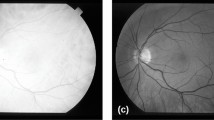Abstract
Purpose
Retinopathies are the leading cause of eyesight loss, especially among diabetics. Due to the low contrast of blood vessels in fundus images, the visual inspection is a challenging job even for specialists. In this context, this work aims to implement image processing techniques to support contrast enhancement and segmentation of retinal blood vessels.
Methods
The initial proposal consisted only of green channel separation, contrast limited adaptive histogram equalization, and 2D Gabor wavelet and mathematical morphology. The new proposal includes the edge and mask detection and the vessel enhancement 2D to preserve image’s characteristics. The development and validation of this work, in MatLab® environment, involved 40 images from Digital Retinal Images for Vessel Extraction (DRIVE), 20 images from Structured Analysis of the Retina (STARE), and 45 images from High-Resolution Fundus (HRF) database.
Results
In the unsupervised method context, the proposal presented the best performance regarding sensitivity and second place for balanced-accuracy on all databases. A subjective validation involving eleven ophthalmology professionals showed higher levels of acceptance (above 80%) after contrast limited adaptive histogram equalization (CLAHE) and vessel enhancement 2D steps and 75.5% for overall quality system.
Conclusion
The main contributions refer to the inclusion of techniques for automatic mask detection, image edge removal, and suppression of vessels background to improve the retinal vessels segmentation process. In addition, this work made a computational interface named “Retinal Lab - A Tool for Fundus Image Analysis” available, which permits the users to adjust the contrast and segmentation of blood vessels in retinal images.






Similar content being viewed by others
References
Aguirre-Ramos H, Avina-Cervantes JG, Cruz-Aceves I, Ruiz-Pinales J, Ledesma S. Blood vessel segmentation in retinal fundus images using Gabor filters, fractional derivatives, and expectation maximization. Appl Math Comput. 2018;339:568–87. https://doi.org/10.1016/j.amc.2018.07.057.
Bosco A, Lerário AC, Soriano D, dos Santos RF, Massote P, Galvão D, et al. Retinopatia diabética. Arq Brasil Endocrinol Metabol. 2005;49(2):217–27. https://doi.org/10.1590/S0004-27302005000200007.
Budai A, Bock R, Maier A, Hornegger J, Michelson G. Robust vessel segmentation in fundus images. Int J Biomed Imag. 2013;2013. https://doi.org/10.1155/2013/154860.
Fan Z, Lu J, Wei C, Huang H, Cai X, Chen X. A hierarchical image matting model for blood vessel segmentation in fundus images. IEEE Trans Image Process. 2019;28(5):2367–77. https://doi.org/10.1109/TIP.2018.2885495.
Gonzalez RC, Woods RE. Digital image processing. 4th ed. New Jersey: Pearson Education; 2018.
Gupta S, Mazumdar SG. Sobel edge detection algorithm. International Journal of Computer Science and Management Research. 2013;2(2):1578–83.
Hoover A, Kouznetsova V, Goldbaum M. Locating blood vessels in retinal images by piece-wise threhsold probing of a matched filter response. IEEE Trans Med Imaging. 2000;19(3):203–10. https://doi.org/10.1109/TMI.2003.815900.
Jain AK, Farrokhnia F. Unsupervised texture segmentation using Gabor filters. In: 1990 IEEE international conference on systems, man, and cybernetics conference proceedings; 1990 Nov 4–7. Los Angeles: IEEE; 1990. p. 14–9. https://doi.org/10.1109/ICSMC.1990.142050.
Liskowski P, Krawiec K. Segmenting retinal blood vessels with deep neural networks. IEEE Trans Med Imaging. 2016;35(11):2369–80. https://doi.org/10.1109/TMI.2016.2546227.
Neto LC, Ramalho GLB, Neto JFSR, Veras MSR, Medeiros FNS. An unsupervised coarse-to-fine algorithm for blood vessel segmentation in fundus images. Expert Syst Appl. 2017;78:182–92. https://doi.org/10.1016/j.eswa.2017.02.015.
Nugroho HA, Lestari T, Aras RA, Ardiyanto I. Segmentation of retinal blood vessels using Gabor wavelet and morphological reconstruction. In: Proceedings of the 3rd international conference on science in information technology (ICSITech); 2017 Oct 25–26; Bandung, Indonesia. USA: IEEE; 2018. p. 513–6. https://doi.org/10.1109/ICSITech.2017.8257166.
Pizer SM, Johnston RE, Ericksen JP, Yankaskas BC, Muller KE. Contrast-limited adaptive histogram equalization: speed and effectiveness. In: Proceedings of the first conference on visualization in biomedical computing; 1990 may 22–25. Atlanta: IEEE; 1990. p. 1990. https://doi.org/10.1109/VBC.1990.109340.
Roychowdhury S, Koozekanani DD, Parhi KK. Blood vessel segmentation of fundus images by major vessel extraction and subimage classification. IEEE J Biomed Health Inform. 2015;19(3):1118–28. https://doi.org/10.1109/JBHI.2014.2335617.
Sazak Ç, Nelson CJ, Obara B. The multiscale bowler-hat transform for the blood vessel enhancement in retinal images. Pattern Recogn. 2019;88:739–50. https://doi.org/10.1016/j.patcog.2018.10.011.
SBD (Sociedade Brasileira de Diabetes) Oliveira JEP, Junior RMM, Vencio S. Diretrizes da Sociedade Brasileira de Diabetes 2017-2018. Editora Clannad; 2018. ISBN: 978-85-93746-02-4. Available from: https://www.diabetes.org.br/profissionais/images/2017/diretrizes/diretrizes-sbd-2017-2018.pdf. Accessed 03 Nov 2018.
Singh N, Kaur L. A survey on blood vessel segmentation methods in retinal images. In: Proceedings of the 2015 international conference on electronic design, Computer Networks & Automated Verification (EDCAV); 2015 Jan 29–30; Shillong, India. USA: IEEE; 2015. p. 23–8. https://doi.org/10.1109/EDCAV.2015.7060532.
Soares JVB, Leandro JJG, Cesar RM, Jelinek HF, Cree MJ. Retinal vessel segmentation using the 2-D Gabor wavelet and supervised classification. IEEE Trans Med Imaging. 2006;25(9):1214–22. https://doi.org/10.1109/TMI.2006.879967.
Staal J, Abramoff M, Niemeijer M, Viergever M, van Ginneken B. Ridge-based vessel segmentation in color images of the retina. IEEE Trans Med Imaging. 2004;23(4):501–9. https://doi.org/10.1109/TMI.2004.825627.
Zana F, Klein J. Segmentation of vessel-like patterns using mathematical morphology and curvature evaluation. IEEE Trans Image Process. 2001;10(7):1010–9. https://doi.org/10.1109/83.931095.
Zhu C, Zou B, Zhao R, Cui J, Duan X, Chen Z, et al. Retinal vessel segmentation in colour fundus images using extreme learning machine. Comput Med Imaging Graph. 2017;55:68–77. Special Issue on Ophthalmic Medical Image Analysis. https://doi.org/10.1016/j.compmedimag.2016.05.004.
Zuiderveld K. Contrast limited adaptive histograph equalization. Graphic Gems IV. San Diego: Academic Press Professional; 1994. p. 474–85.
Acknowledgments
The authors would like to thank J. J. Staal, A. Hoover, and their colleagues for making their databases publicly available and Dr. Ricardo Guimarães Eye Hospital for the support in taking the subjective tests.
Funding
This study was financially supported in part by CAPES-Finance Code 001.
Author information
Authors and Affiliations
Corresponding author
Additional information
Publisher’s note
Springer Nature remains neutral with regard to jurisdictional claims in published maps and institutional affiliations.
Rights and permissions
About this article
Cite this article
da Rocha, D.A., Barbosa, A.B.L., Guimarães, D.S. et al. An unsupervised approach to improve contrast and segmentation of blood vessels in retinal images using CLAHE, 2D Gabor wavelet, and morphological operations. Res. Biomed. Eng. 36, 67–75 (2020). https://doi.org/10.1007/s42600-019-00032-z
Received:
Accepted:
Published:
Issue Date:
DOI: https://doi.org/10.1007/s42600-019-00032-z




